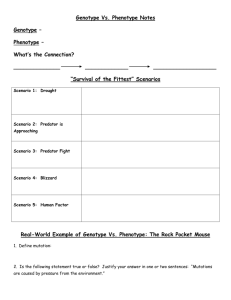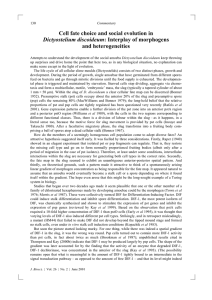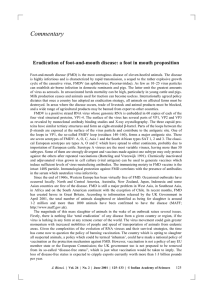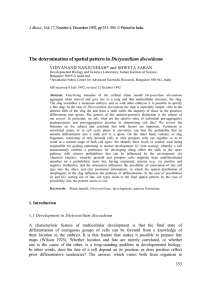Who laughs last? perturbation theory of games ,
advertisement
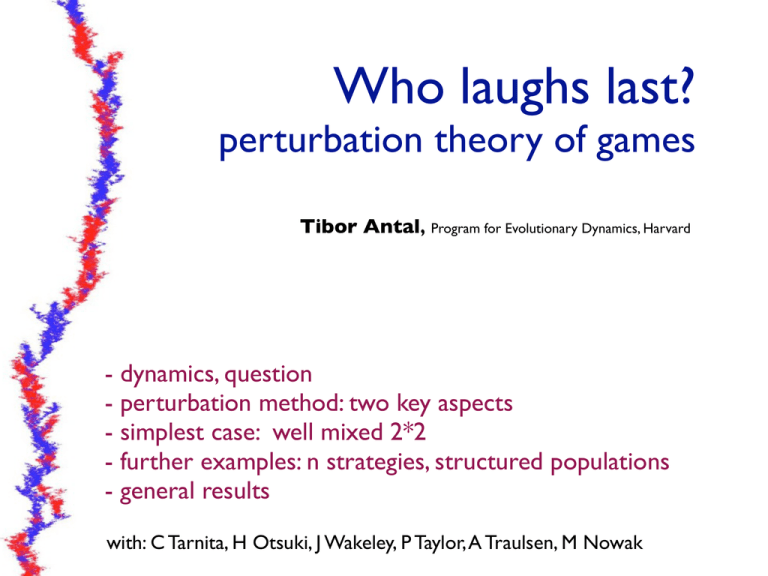
Who laughs last? perturbation theory of games Tibor Antal, Program for Evolutionary Dynamics, Harvard - dynamics, question - perturbation method: two key aspects - simplest case: well mixed 2*2 - further examples: n strategies, structured populations - general results with: C Tarnita, H Otsuki, J Wakeley, P Taylor, A Traulsen, M Nowak Pleiotropy as a mechanism to stabilize cooperation Cooperation Kevin R. Foster1*, Gad Shaulsky2, Joan E. Strassmann1, David C. Queller1 & Chris R. L. Thompson2,3* 1 Ecology and Evolution, Rice University, Houston, Texas 77005, USA Department of Molecular and Human Genetics, Baylor College of Medicine, One Baylor Plaza, Houston, Texas 77030, USA 3 School of Biological Sciences, University of Manchester, Manchester M13 9PT, UK 2 humans, bacteria, trees, slime molds, ... * These authors contributed equally to this work. ............................................................................................................................................................................. Most genes affect many traits1–4. This phenomenon, known as pleiotropy, is a major constraint on evolution because adaptive change in one trait may be prevented because it would compromise other traits affected by the same genes2,4. Here we show that pleiotropy can have an unexpected effect and benefit one of the most enigmatic of adaptations—cooperation. A spectacular act of cooperation occurs in the social amoeba Dictyostelium discoideum, in which some cells die to form a stalk that holds the other cells aloft as reproductive spores5,6. We have identified a gene, dimA7, in D. discoideum that has two contrasting effects. It is required to receive the signalling molecule DIF-1 that causes differentiation into prestalk cells. Ignoring DIF-1 and not becoming prestalk should allow cells to cheat by avoiding the stalk. However, we find that in aggregations containing the wildtype cells, lack of the dimA gene results in exclusion from spores. This pleiotropic linkage of stalk and spore formation limits the potential for cheating in D. discoideum because defecting on prestalk cell production results in an even greater reduction in spores. We propose that the evolution of pleiotropic links between cheating and personal costs can stabilize cooperative adaptations. Acts of cooperation such as stalk formation in D. discoideum are a challenge for evolutionary biologists because of the potential for disruptive cheaters8–12. When starving, the normally solitary amoebae of D. discoideum aggregate together to form a migratory slug and then a fruiting body in which most cells become spores but around one-fifth die to form a supporting stalk5,6. Genetically different clones of D. discoideum will aggregate together and form chimaeric fruiting bodies5 and chimaerism seems to be common in nature because multiple clones co-occur in tiny soil samples13. This suggests that a defector12 that produces fewer stalk cells can gain a selfish advantage5 and raises the question of how stalk formation is maintained9,11. Around half of prestalk cells in D. discoideum, known as the prestalk O cells, are induced to differentiate by the signalling molecule DIF-1 (ref. 14), that is released by the neighbouring prespore cells15 (Fig. 1a). A viable cheating strategy, therefore, would be to ignore DIF-1 and overproduce spore cells in chimaeras. This is supported by the observation that cells with lowered DIF sensitivity, resulting from growth with glucose, cheat and are over represented in the spores when mixed with cells grown without glucose16,17. We used a knockout mutant to examine the effects of ignoring DIF-1. dimA encodes a central component of the DIF response pathway. A mutant with this gene disrupted (dimA 2) ignores DIF-1 Foster ‘04 prisoner's dilemma 7 C D ! " C 10 1 . D 11 2 defectors win! Figure 1 dimA 2 cells occupy the prespore zone and behave like a cheater in chimaeras. a, A schematic diagram of a slug of the slime mould Dictyostelium discoideum showing three of the major cell types: prestalk A (pstA), prestalk O (pstO) and prespore cells. Prespore cells release DIF-1, which induces pstO cell differentiation. b, Schematic Evolutionary Dynamics Moran process, N players Game replication payoff of random death 0 1 when playing against A A a11 B a21 B a12 a22 µm λm 2 3 m N-1 N + t1 − tN −1 + t1 = − tN −1 TA, Scheuring '06 What is the question? Two strategies: A and B: Which one is better? B John Forbes Nash, John Maynard Smith fixation probabilities ... A Or: Which outnumbers the other in the long run? with two way mutation u !x" > 1/2 Kandori '93 u→0 x fixation probabilities ρA > ρB x general time u time Perturbation method: 2 key points when playing against A Payoff = 1 + δ × payoff of B A a11 B a21 Wright-Fisher a12 a22 x δ u frequency of A selection strength mutation probability t selection ∆x mutation ∆x sel mut t+1 ∆x tot = ∆x sel u u sel − (x + ∆x ) + (1 − x − ∆xsel ) 2 2 1 1−u !x" = + !∆xsel " 2 u 1 sel !x" > ⇐⇒ !∆x " > 0 2 Perturbation method: 2 key points when playing against A Payoff = 1 + δ × payoff of A a11 B a21 B a12 a22 x δ u frequency of A selection strength mutation probability 1 sel !x" > ⇐⇒ !∆x " > 0 2 Easy perturbation method for small δ ! (1) ∆xi = 0 + δ∆xi !∆x" = ∆xi πi (0) πi = πi !∆x" = δ ! (1) ∆xi (0) πi + O(δ ) 2 (1) + δπi neutral probabilities only ! Simplest example payoffs: ! 1 T S 0 " well-mixed fA = 1 + δ [X − 1 + S(N − X)] fB = 1 + δ(XT + 0) ∆x sel ! 3 " 2 2 = δN (x − x )(1 − S − T ) + (x − x )(S − 1/N ) average in the neutral stationary state !∆xsel " > 0 !∆x" = δ ! ! 1 T <1−S+ S− N 2 T <S+1− N Kandori '93, TA, Traulsen, Nowak '09 Example: (1) (0) ∆xi πi " + O(δ 2 ) !x" − !x2 " !x2 " − !x3 " =2 neutral correlations from coalescence 1 T = 1, S = 2 A wins for N=5, but B wins for N=3 !x" − !x2 " = 2 2 3 !x " − !x " Correlations from coalescent 1 !x" = 2 1 !x " = Pr(Sk = Sl ) 2 2 1 !x " = Pr(Sk = Sl = Sq ) 2 3 MRCA time time Pr(Sk = Sl ) = ! t Pr(Sk = Sl |T = t)Pr(T = t) n strategies: when is k better than average? a11 .. . an1 a12 ... ... ... Low mutation a1n .. . ann n ! 1 Lk = (akk + aki − aik − aii ) > 0 n i=1 High mutation n = 2 : a11 + a12 > a21 + a22 n ! n ! 1 Hk = 2 (akj − aij ) > 0 n i=1 j=1 Arbitrary mutation Lk + N uHk > 0 Example 1 λ = 4.6 0.340 x1 S2 0 λ 7 S3 13 8 9 Abundances S1 S1 1 S2 0 S3 0 N = 30 0.336 δ = 0.003 x2 0.332 µ = Nu x3 0.328 0.1 1 Mutation Rate µ S1 S1 1 S2 0 S3 0 S2 0 λ 7 S3 13 8 9 10 Example 2 Defectors beat Cooperators since a11 + a12 < a21 + a22 C D ! " C 10 1 . D 11 2 C C 10 D 11 L 0 But lets add Loners D 1 2 0 L 0 0 0 8 LC = , 3 4 LD = , 3 LL = −4 C win HC = 1, 5 HD = , 3 8 HL = − 3 D win General, C win for µ < µ ≡ 1 ∗ Example 3 m round Prisoner's dilemma AllC AllC (b − c)m AllD bm TFT (b − c)m AllD −cm 0 −c TFT (b − c)m b (b − c)m b 3m = c m−1 b 5m + 1 = c m−1 b 3m + 1 = c m−1 4m − 1 b = c m−1 b 2m + 1 = c m−1 AllC better than average 5m + 1 b = c 2(m − 1) b 2m + 1 = c m−1 b m+2 = c m−1 b m+1 = c m−1 b benefit, c cost Islands: simplest structured population C C DD DC D u β strategy mutation position mutation D " ! C C b − c −c b 0 D y = Pr(Sk = Sq ) z = Pr(Xk = Xq ) Sk g = Pr(Sk = Sq , Xk = Xq ) Xk h = Pr(Sl = Sk , Xk = Xq ) ! "∗ b z−h = c g−h strategy position ! "∗ # $ b M +r+2+µ M (1 + µ) 3+µ 1 = + − c M −1 (M − 1)(2 + µ) r r+2+µ M=2 islands 20 µ = 2N u r = 2N β 10 5 0 2 4 6 r 8 10 island size dependence (µ = 0) 10 M=2 3 5 10 oo 8 * 0 µ=2 µ=1 µ=0 6 (b/c) (b/c)* 15 4 2 0 0 2 4 6 r 8 10 Evolution in phenotype space Moran 75 birth β 1 − 2β β N =7 random death phenotype Evolution in phenotype space birth β 1 − 2β β N =7 random death phenotype Evolution in phenotype space N =7 phenotype disperse or condense ? Group of size √ r diffuses as D = r/2 r = Nβ u Colors Mutation y = Pr(Sk = Sq ) z = Pr(Xk = Xq ) Sk g = Pr(Sk = Sq , Xk = Xq ) Xk strategy position h = Pr(Sl = Sk , Xk = Xq ) D " ! C C b − c −c b 0 D onsite play phenotype ! "∗ b z−h = c g−h TA '09 β = 1/2, µ = 1/2 10 Simulation Theory 8 8 6 6 (b/c)* (b/c)* 10 4 4 √ 1 + 12 2 7 2 0 0 10 r=1 r=2 r=4 r=∞ 2 20 30 40 50 0 N 0 1 2 3 µ µ = 2N u r = 2N β 4 5 Coop Def Coop ! 1 T̂ Def " Ŝ 0 T̂ < Ŝ + 1 + √ 3 Fig 1 Higher dimensions phenotype II Sets ? phenotype I Graphs Tarnita '09 Tarnita '09 One parameter to rule them all A wins iff when playing against σa + b > c + σd single parameter for all structures payoff of classical well mixed σ = 1 a+b>c+d (risk dominance) √ !A A a B c B" b d or σ = 1 − 2/N phenotype game σ = 1 + 3 more strategies on structure? # strategies 2 ≥3 # parameters 1 2 Wage, Tarnita '10 Relations to relatedness A wins iff b 1 > c R (Hamilton's rule) same size islands Pr(Sk = Sq |Xk = Xq ) − Pr(Sk = Sq ) R= 1 − Pr(Sk = Sq ) fluctuating size islands, phenotype walk ! "∗ b z−h = c g−h Pr(Sk = Sq | Xk = Xq ) − Pr(Sl = Sk | Xk = Xq ) R= 1 − Pr(Sl = Sk | Xk = Xq ) TA '09, Taylor '10 sets, more general structures no relatedness interpretation of our general formulas Final slide general method to study weak selection TA, Ohtsuki, Wakeley, Taylor, Nowak, PNAS '09 papers can be found on my website thanks




